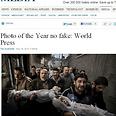
Coverage of photo scandal in Australian paper
Palestinian funeral photo chosen as picture of year might be fake
Website claims lab investigation revealed World Press Photo's picture of year of Palestinian funeral procession for children killed in Gaza comprised of number of different photos, seriously enhanced
Swedish photographer Paul Hansen's photo titled "Gaza Burial" portraying a Gaza funeral procession for children killed during Operation Pillar of Defense, is inspiring controversy worldwide in recent days, but this time for artistic – and not political – reasons.
The reason - tech blog Extremtech claims the picture underwent massive manipulation and was put together from a number of different photographs with the help of photoshop.
Related stories:
Despite the fact that Operation Pillar of Defense ended with a considerably low number of civilian fatalities in comparison to Operation Cast Lead four year earlier, upon publication, Hansen's picture hit Israeli hasbara missions hard.
Dr. Neal Krawetz from Extremtech, claims that a lab analysis – in which he specializes – revealed Hansen's photo underwent serious "enhancement" and is a fake or at least "digitally modified."

Gaza Burial. Hansen (Photo: AFP)
According to Extremtech's report, "The photo itself is almost certainly a composite of three different photos, with various regions spliced together from each of the images, and then further manipulation to illuminate the mourners’ faces."
Krawetz further claims the picture was reedited not long before the World Press Photo's submission deadline in January.
"I cannot tell you about the original picture, but I can tell you that the controversial picture is definitely not original." Krawetz is quoted as saying, adding "it appears to have been modified specifically for this contest."
It is important to stress that the claim is not that Hansen did not shoot the funeral procession of children killed during the operation, but rather that the amount of editing that went into it afterwards exceeded professional standards and those of the common sense conception of photo journalism to such an extent that it can no longer be considered objective.
In wake of the blogger's claims, there are those calling for the World Press Photo, the organization behind the prize – considered to be the most prestigious in the world of photojournalism – to strip Hansen of his prize.
Hansen himself has rejected the claims and said that he only used digital tools to put the final touches on the photo, to brush it up and improve the colors and contrast because of the uneven distribution of light in the alley in which the photo was taken.
Hansen said the "photograph is certainly not a composite or a fake," adding that "I have never had a photograph more thoroughly examined, by four experts and different photo-juries all over the world."
The World Press Photo supported Hansen's claims, saying it had reviewed the picture. "It is clear that the published photo was retouched with respect to both global and local color and tone," it said.
"Beyond this, however, we find no evidence of significant photo manipulation or compositing. Furthermore, the analysis purporting photo manipulation is deeply flawed," the organization concluded.
Nonetheless, it decided to send to picture for an additional analysis which also rejected the claims, "therefore ruling out any question of a composite image,” a statement from the organization said.
- Receive Ynetnews updates directly to your desktop










